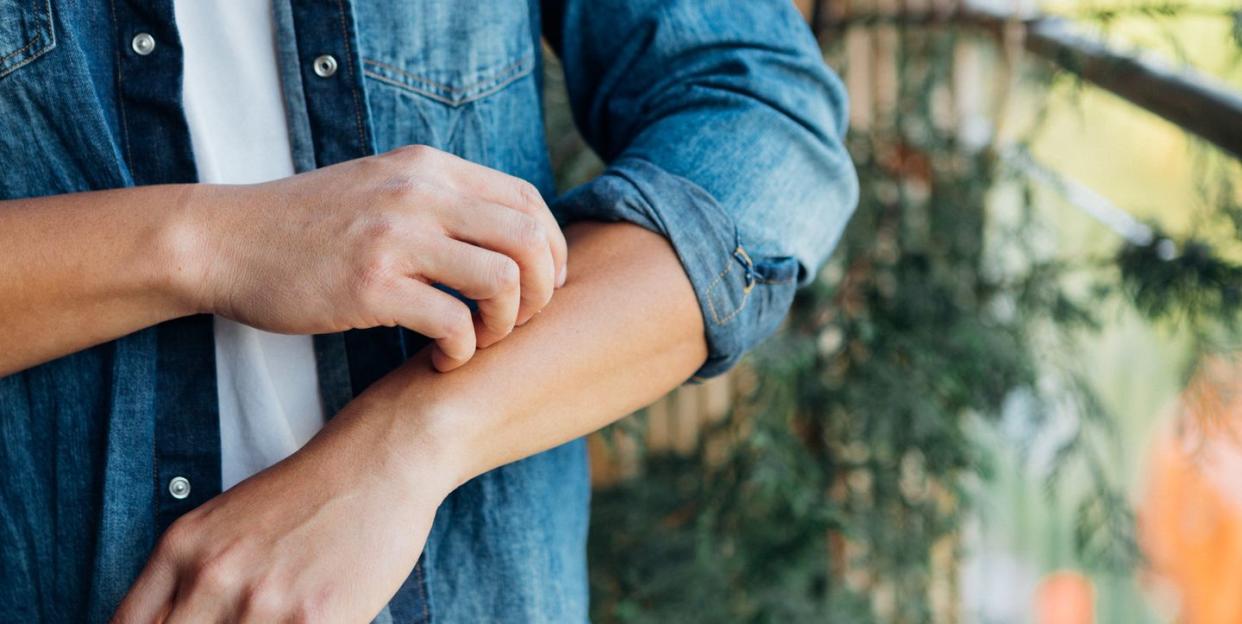The 6 Fastest Ways to Clear Up Poison Ivy

"Hearst Magazines and Yahoo may earn commission or revenue on some items through the links below."
Hiking on that trail seemed like a good idea…until you came back with poison ivy. Digging around in the garden can give you the same. If you’re one of the people who has a reaction to this unfriendly plant, you may be wondering just how fast you can cure an outbreak and return to being active. The answer is somewhere along the lines of: faster than you think, but slower than you wish.
According to Joshua Zeichner, MD, an associate professor in the department of dermatology and the director of cosmetic and clinical research at the Mount Sinai Hospital in New York City, poison ivy, and its cousins poison oak and poison ivy sumac, contain a resin on their leaves that leads to an allergic reaction in the skin known as contact dermatitis. If you come into contact with these plants by brushing up against any shrubs or vines, you’ll want to make sure to clean your skin of any residue from them ASAP.
“If you have been exposed to the plant, it’s important to thoroughly wash the skin with soap and water as soon as possible,” he explains. “While the rash is not contagious, if there is fresh resin on part of your body, it will cause a rash on other parts of the body that it touches.”
If you have been exposed to poison ivy, it’s not only extremely important to wash your hands, but also not touch your eyes or genitals. No surprise, a poison ivy reaction on the skin in these areas is...let’s just say extremely uncomfortable.
So what can you do to treat and eliminate poison ivy, stat? First of all, manage your expectations. Of course you’d like to cure that poison ivy rash overnight. Unfortunately, it’s going to take longer than that. It takes about a week to clear, and if 7 to 10 days have passed and it’s not improving, see a doctor.
How to treat poison ivy fast
1) Reach for creams and lotions
Dr. Zeichner recommends reaching for over-the-counter moisturizers to hydrate the skin and repair the skin barrier. Vaseline Intensive Care Essential Healing Lotion, for example, contains triple purified petrolatum to form a breathable seal over the skin. It also contains oat extract to calm inflammation, he says.
“Anti-itch ingredients like calamine lotion can be very effective, symptomatically improving the feel of the rash and reducing your need for scratching,” he explains. “Anti-itch cream like 1% hydrocortisone can also be effective. However, don’t apply cortisone cream for more than two weeks in a row and make sure to touch base with your doctor if it is not working.”
2) Consider oral corticosteroids
According to Brian Kim, MD, co-director at the Center for the Study of Itch at Washington University School of Medicine in St. Louis, one of the most effective treatments for poison ivy are corticosteroids, typically oral rather than topical.
“Topical steroids work as well but they are not as potent,” he says. “We recently found a new pathway that causes itch in poison ivy-type dermatitis and this could be a new future therapeutic approach.” Steroid pills or injections tend to be used for poison ivy rashes that cover large or delicate areas of the body.
3) Try an oatmeal bath…
According to the American Academy of Dermatology, a warm bath with a colloidal oatmeal solution can help relieve itching. You can find products like Aveeno Soothing Bath Treatment at your local drugstore.
4) Or a baking soda bath
Similar to an oatmeal bath, the AAD recommends drawing a lukewarm bath and adding a cup of baking soda to the running water. This should have the same soothing effect.
5) Or a cold shower…
Or if cold relief is more your thing, the AAD also recommends taking a short, cool shower. This will hopefully ease itching as well.
6) Apply a cool compress
Soak a clean washcloth in cold water and wring it out so it doesn’t drip. Then apply it to the affected itchy skin to bring relief.
Don’t be tempted to use antihistamines to stop the itching; they don’t help relieve the itching you get with contact dermatitis caused by poison ivy, according to the medical resource Up To Date.
Naturally, you’re not going to find these items the moment you need them up in the mountains or out in the woods, so if you’re prone to poison ivy reactions or are visiting an area where you know you’re likely to have an encounter, make a note to purchase and pack these products before your next adventure into the great outdoors.
You Might Also Like